Brief History
By an ex-parte order of the GoI, the OROP that the veterans enjoyed since independence was withdrawn in 1973. Because of their peculiar service conditions and short lengths of service (most men retire between 35 to 37 years so as to have them as jawans (young men) in the armed forces), they were at that time given 70 % of last pay drawn as pension and civil service personnel 33 %. By the same order, it was raised to 50 % for civil services and reduced to 50 % for officers and 37 % for men.
Several representations by armed forces followed. Typically, the government appointed committees and commissions such as 3rd CPC in 1973, Estimates Committee, 1980-81, KP Singh Deo Committee of 1984, 4th CPC in 1987, Jafa Committee of 1989, Sharad Pawar Committee of 1990-91, 5th CPC, GoM Committee of 2005, and 6th CPC in 2006. Instead of restoring OROP, the government in 2008 provided OROP to civil and police services in 2008 at highest pay grades and they made sure, by an internal memo, that 100 % of them became eligible to do so because of NFU (Non-functional Financial Upgradation; which meant that if one in a batch was promoted, the others automatically became eligible to draw the increased pay).
This was betrayal of the worst kind. Agitations followed and veterans returned medals to the President at Jantar Mantar, New Delhi. Govt appointed a Ten Member committee under BJP MP Bhagat Singh Koshiyari. In Dec 2011, the committee gave report strongly favouring OROP and gave a definition of OROP accepted by all parties including the parliament. Since then, two parliaments have passed the OROP but is yet to be implemented.
Shri Narendra Modi declared in election campaign at Rewari, Haryana, on 15th Sep 2013, that his government would implement OROP within 100 days of coming to power. Again, on 2014 Diwali day at Siachin, the PM announced OROP to soldiers. However, the RM’s announcement of OROP on 5th Sep 2015 (after 16 months of being in power) was an apology for OROP. It has seven distinct shortcomings and if implemented in the present form it would totally kill the very definition of OROP. The UFESM (United Front of Ex-Servicemen) decided to, therefore, continue with the renewed agitation that started on 14th June 15 at Jantar Mantar including Relay Hunger Strikes from 15th June 15. Rallies are being held across the country to make people aware of the machinations of the babus-netas who have relentlessly denied OROP to veterans after withdrawing it in 1973 within 18 months of the 1971 War victory.
Koshiyari Committee Report and the Flaws in GoI Announcement on 05 Sep 15
Post 2008 agitations, a ten member committee was appointed under the BJP MP Bhagat Singh Koshiyari. It gave its report in Dec 2011 and not just strongly recommended OROP to be implemented but gave a definition of OROP as follows:
OROP “implies that uniform pension be paid to the Armed Forces Personnel retiring in the same rank with the same length of service irrespective of their date of retirement and any future enhancement in the rates of pension to be automatically passed on to the past pensioners.” The concept includes “bridging the gap between the rate of pension of the current pensioners and the past pensioners, and also future enhancements in the rate of pension to be automatically passed on to the past pensioners. In armed forces, equality in service has two components, namely, rank and length of service. The importance of rank is inherent in armed forces as it has been granted by the President of India and signifies command, control and responsibility in consonance with ethos of service. These ranks are even allowed to be retained by the individual concerned after his/her retirement. Hence, two armed personnel in the same rank and equal length of service should get same pension irrespective of date of retirement and any future enhancement in rates of pension be automatically passed on to the past pensioners.”
The Koshiyari Committee definition of OROP was accepted by the government, endorsed by the parliament and by the ex-servicemen organisations. Since then two parliaments approved OROP. But, the government’s announcement on OROP on 05 Sep 15 fell much short of the approved definition of OROP. It has the following serious flaws:
- It brought out that those who seek VRS (Voluntary Retirement Scheme) would be kept out of the OROP. This shocked all those engaged in the agitation. It appears that this particular clause has been added at the last minute at the behest of the bureaucracy who is hell-bent to deny the complete OROP to the veterans. Armed forces, unlike some corporates and public sector units, do not have the concept of VRS. They have Pre-Mature Retirement (PMR). Now, if a person has completed his pensionable service and then sought PMR, why should he or she be denied OROP?
- The government has declared that a review of the pensions would be done every five years. This means that in this period of five years pensioners would have five different pensions and not one as envisaged in Koshiyari definition of OROP.
- The base year for calculation of OROP has been selected as calendar year 2013 and not financial year 2013-14 as is normally the basis of all salary and pension related matters. Again, there is an attempt to deny the increments that would have been due in a financial year.
- The government has been petty-minded even for the date of award. They had agreed to the date of 01 Apr 14 in all talks with ESMs. But, at the last minute changed it to 01 Sep 14.
- Whilst earlier the government had agreed to provide pension at the highest point of pay band for a rank, the government has done a volte-face and now conceived to provide it at mean average of lowest and highest points.
- Government plans to appoint a one man judicial council to decide the matter in six months time against the suggested constitution of five members: one each veterans from each service, one serving armed forces member and one bureaucrat. The ESM have also questioned that six months shouldn’t be required after 42 years and the report should be ready in one month’s time.
- OROP should have been awarded in perpetuity and not linked to pay commission as the government has done.
Sense of Betrayal and the Agitation Continues
Many of our countrymen initially, after the GoI announcement on 05 Sep 15, felt that whereas the government seems to have gone out of its way to announce OROP, the ex-servicemen appear to be fussy in continuing with the agitation. Gradually, it has dawned on our people that the chasm between the neta-babu nexus before the announcement seem to have deepened with the announcement. There has been a deep-rooted sense of betrayal that several governments played into the hands of the babus to deny the full and accepted definition of OROP and that, even after 42 years, the BJP government keen to take credit for finally announcing OROP, has taken refuge in petty-mindedness rather than large-heartedness. The government should have also known that the government is not authorised to tinker with OROP after it has been approved twice by two parliaments.
It was, therefore, decided by United Front of ESM (UFESM) to continue with the agitation until full implementation of OROP. There have been promises galore in the last several decades. The latest ones have been by Prime Minister Narendra Modi’s goverment that it would be implemented within 100 days of NDA government coming into power (it did in May 2014 and the OROP is still to be implemented). There are latest ones going around that it would be implemented after Bihar elections, and by Diwali. These really sound hollow after so many betrayals.
Mumbai Rally at Historic Azad Maidan, Saturday, 31st Oct 15
The UFESM under Major General Satbir Singh, SM, Retd., therefore, decided to continue with the agitations and spread awareness amongst the citizens of India by holding rallies in various parts of the country such as Ambala, Dharamshala, and Chennai. The last rally was in Jalandhar, Punjab, and the next is in the historic Azad Maidan in Mumbai on 31st Oct 15. It is the same venue where the Father of the Nation, Mahatma Gandhi held a rally against the British in Dec 1931.
A video of the issues of the forthcoming rally has been prepared by Navi Mumbai TV (NMTV) under the guidance of Commander SH Kalawat, Retd., Convener of ESM in Mumbai, Colonel Harbhajnik Singh, Retd., our point-man for dealing with the press, and self:
https://youtube.com/watch?v=ej2uRX92s9k%3F
There has been concerted media and social media campaign. We addressed a press-conference on 26 Oct 15:
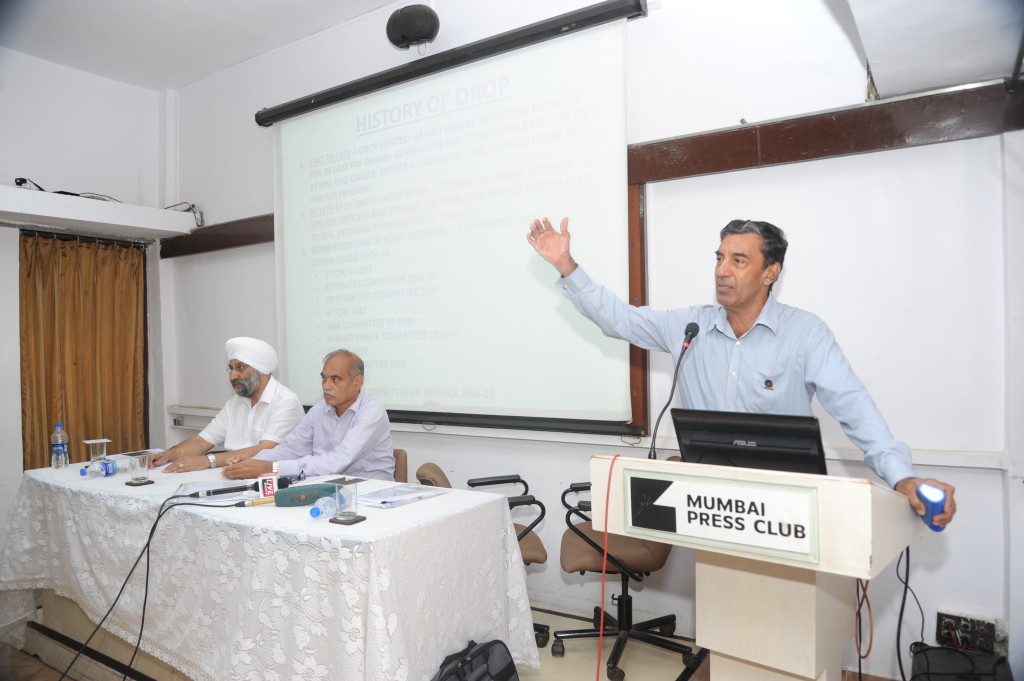 Some glimpses of the social-media campaign besides articles and stories:
Some glimpses of the social-media campaign besides articles and stories:
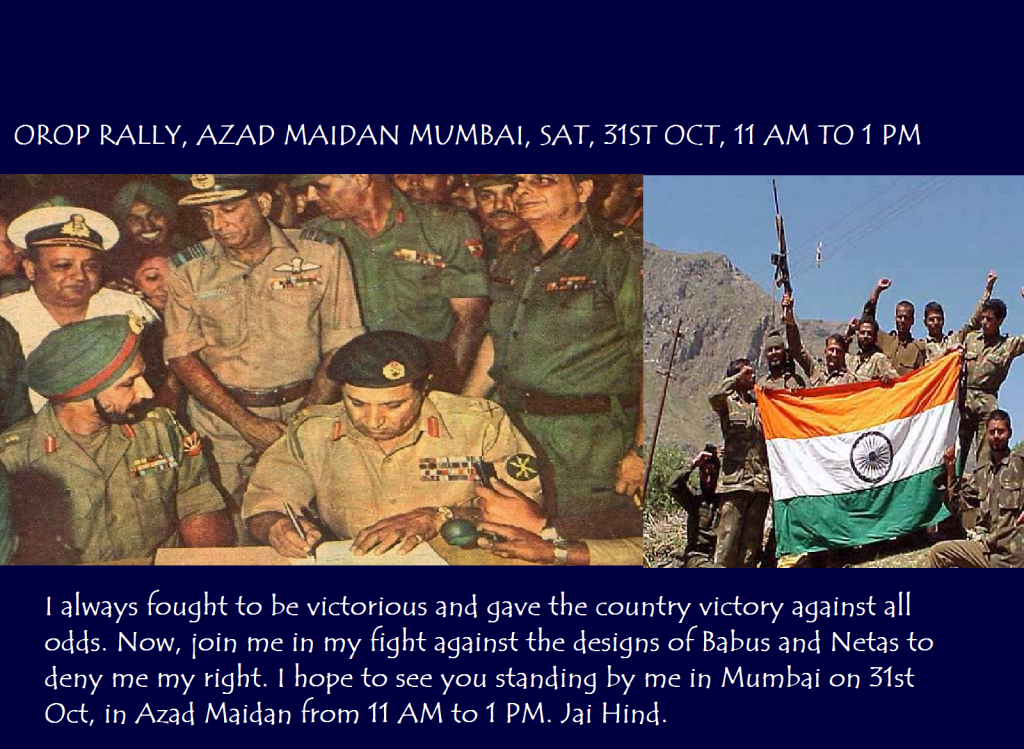
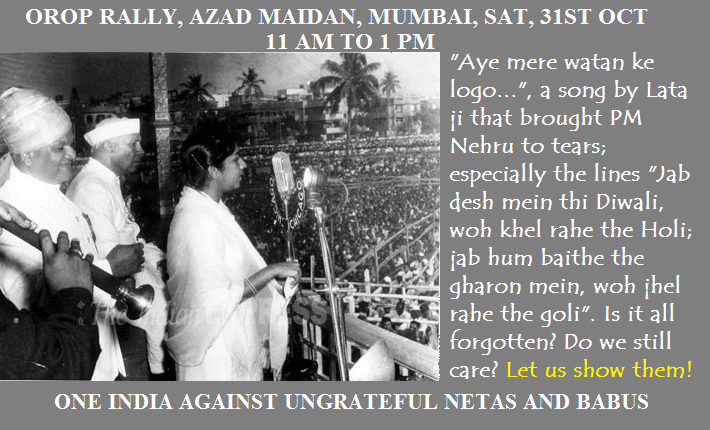
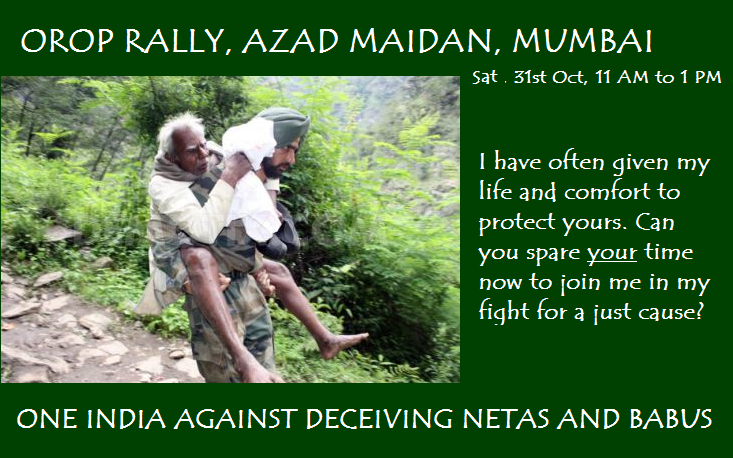
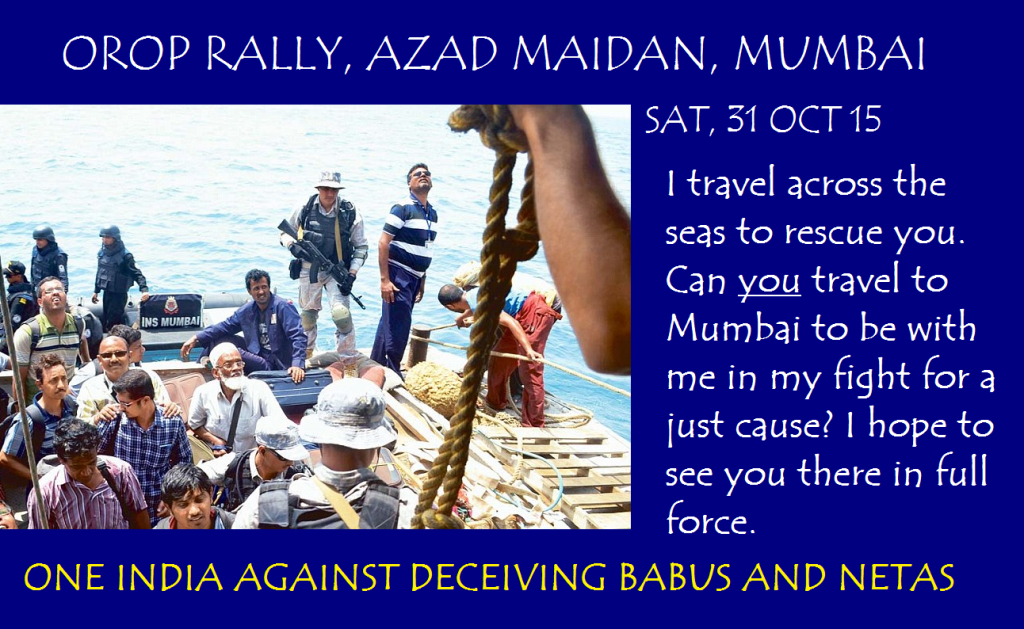
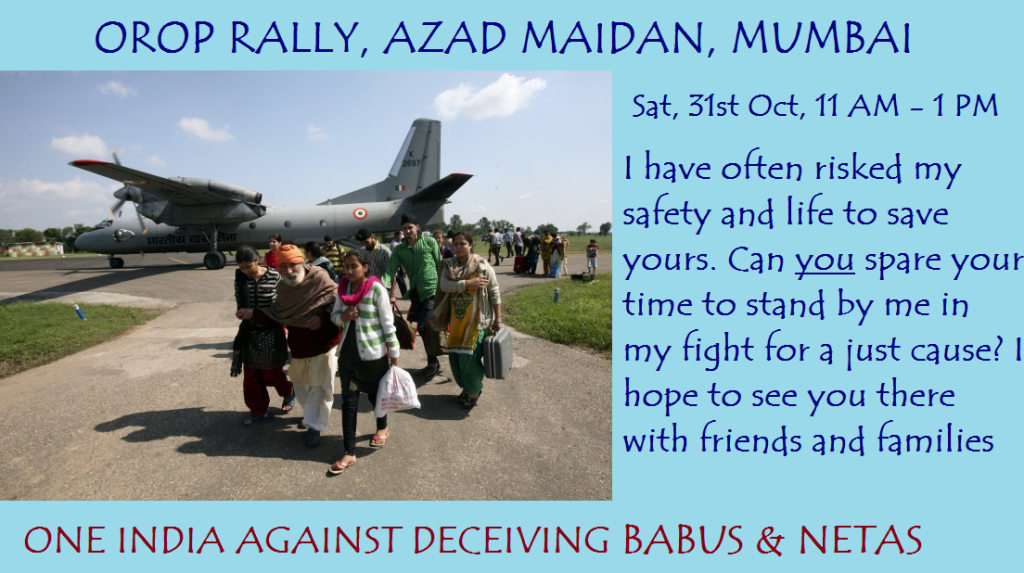 The issues are, therefore, in public domain. We request all veterans and families and citizens of this great city of Mumbai to join us in our fight for the just cause.
The issues are, therefore, in public domain. We request all veterans and families and citizens of this great city of Mumbai to join us in our fight for the just cause.
In the end, as Major General Satbir and other veterans have often said, it is not an issue of money; it is an issue of dignity and izzat of the veterans.
Jai Hind
Jai Hind ki Sena
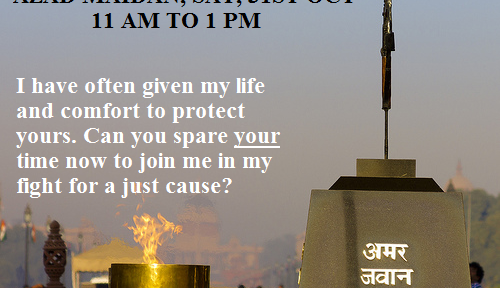
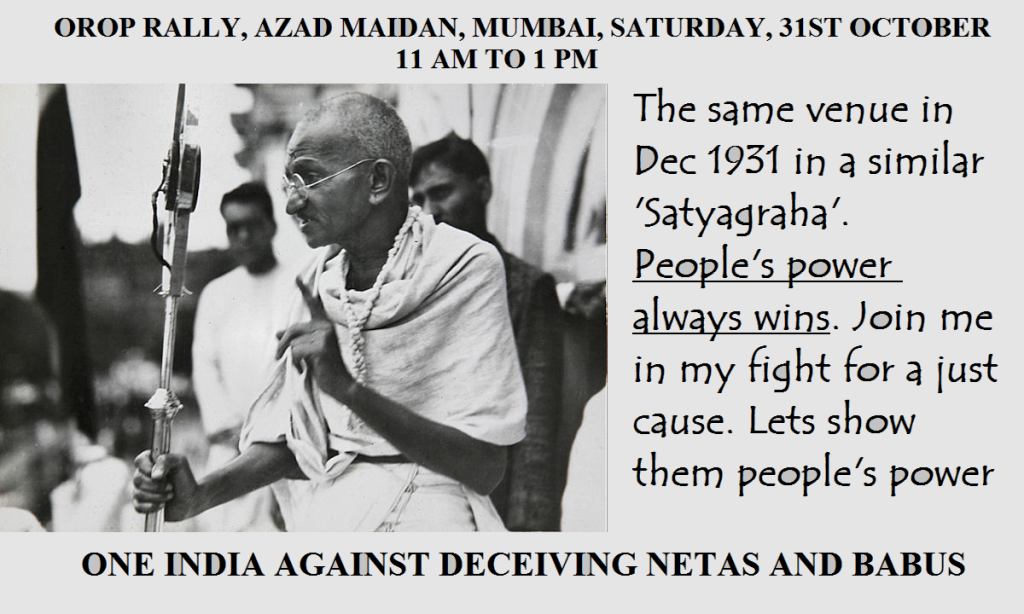
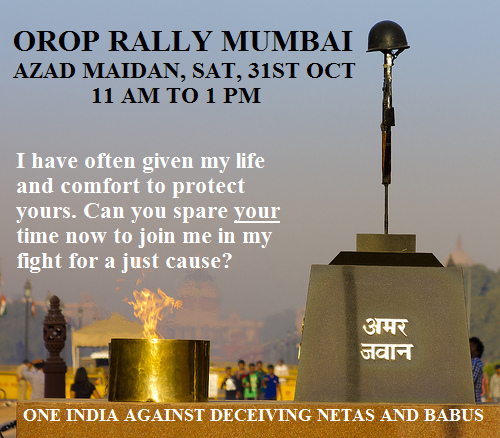
The document and the video should be separated.
The video on the net should be in a smaller format like MP4 which can be seen without breaks and downloaded and distributed to those who are not or do not have an internet connection.
HD version may be distributed seperately on CD’s for viewing over large screens etc.
Thank you Colonel Chavan. The video and the document actually exist separately, as suggested by you. The video is available as a stand-alone You Tube video and a much shorter version of 1 minute is also available. Here in this comprehensive document only the link to the You Tube video is given. Regards.